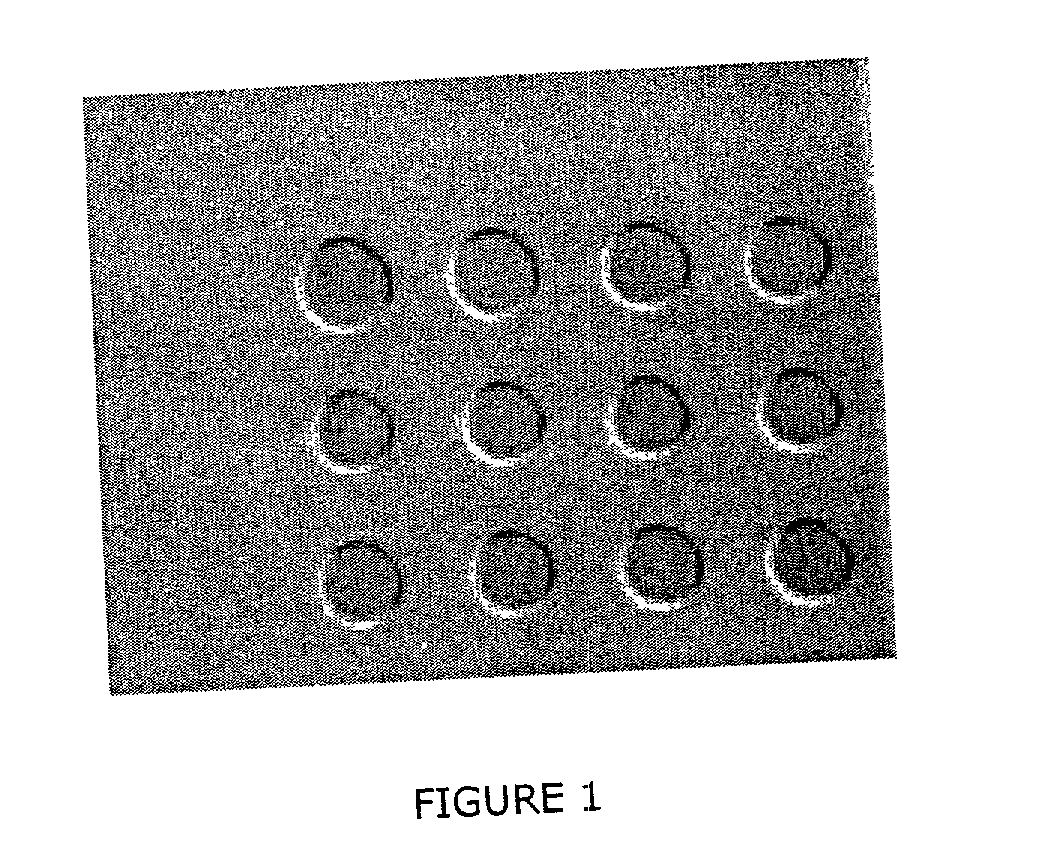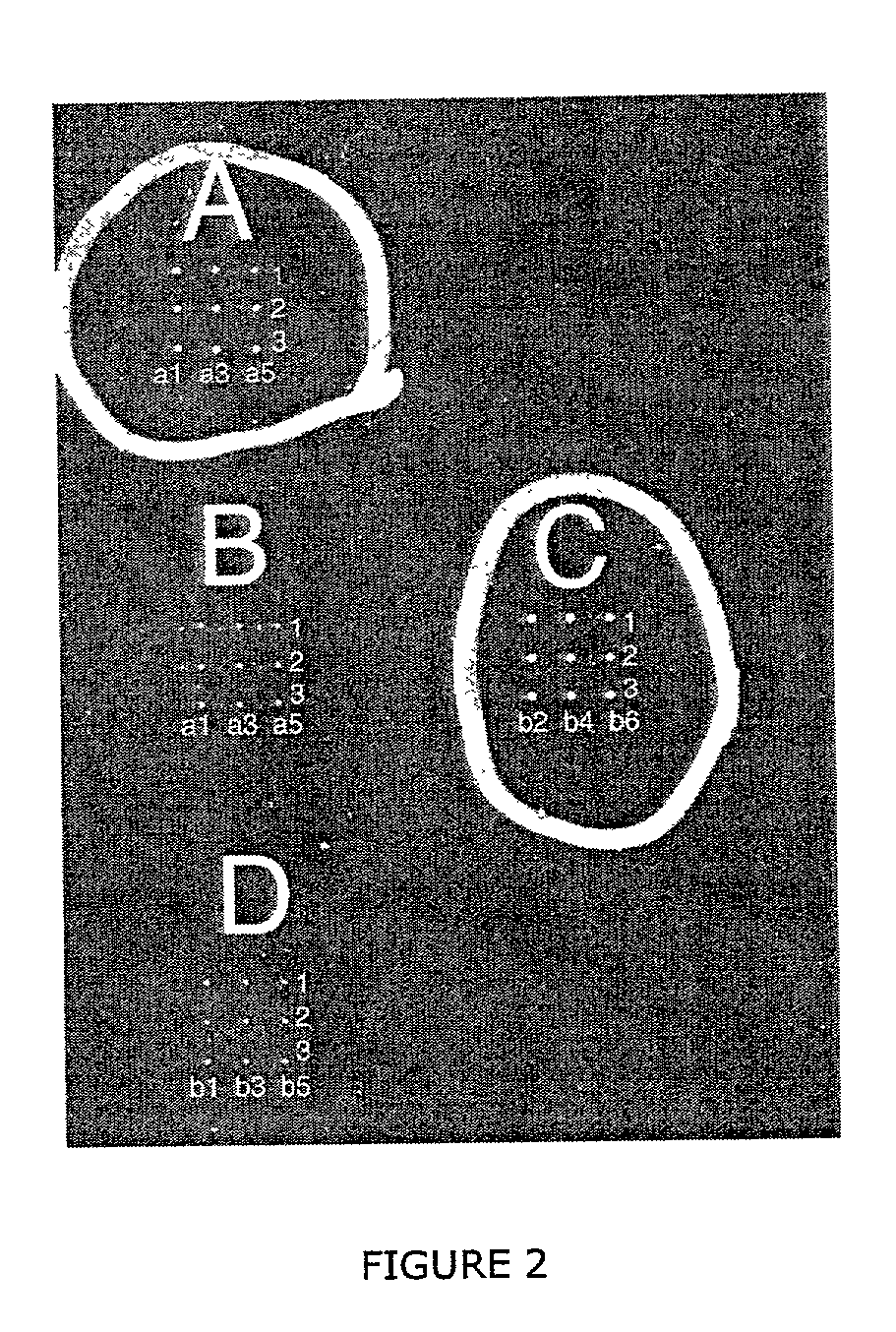Method for the preparation of optical (bio)chemical sensor devices
- Summary
- Abstract
- Description
- Claims
- Application Information
AI Technical Summary
Benefits of technology
Problems solved by technology
Method used
Image
Examples
example 1
Modifications of a Commercially Available "Pin-Ring"-Arrayer
[0115] A commercially available "Pin-Ring"-arrayer (Affymetrix 417, formerly from Genetic Microsystem as GMS 417) is adapted for the deposition of spotting fluids comprising polymer or polymer precursors rather than biological or biochemical fluids, i.e. adapted for continuous use with organic solvents like ethanol for washing of the pins. Tubings--commonly silicone--are exchanged for more solvent-resistant FEP (fluorethylenpropylene) tubing. In a similar manner, the pumps (AS Thomas) that transport the washing liquid into the wash stations are removed and replaced by the same model in the "chemically resistant" version. The protective lock of the door is deactivated to allow access to the pins for manual washing with tetrahydrofuran using a wash bottle. Flow restrictors rather than clamps (or in addition to clamps) are mounted onto the washing solvent tubing to allow increased control of the solvent spurting out of the noz...
example 2
Preparation of a Plurality of Miniaturized PVC Dots on Glass Materials
[0116] 33 mg of poly(vinyl chloride) (PVC) (high molecular weight) and 66 mg plasticizer bis(2-ethylhexyl) sebacate (DOS) are dissolved in 800 .mu.L cyclohexanone. 35 .mu.L of the resulting spotting fluid are filled in well A1 of a 256-well polypropylene microtiter-plate. Using the GMS 417 arrayer with 125 .mu.m-pins, demonstration arrays of PVC dots can easily be deposited on substrates such as commercially available glass or gold-coated glass microscope slides (FIG. 1). Other support surfaces may be placed in the instrument by employing custom-made metal adapter plates. The pin is washed with tetrahydrofuran in order to remove PVC-DOS residues. This may be done manually, or suitable solvents may be used in the washing lines and bath in a correspondingly adapted instrument.
example 3
Preparation of a Plurality of Miniaturized Sodium-Selective (Bio)Chemical Sensor Dots
[0117] 2.9 mg of 9-(diethylamino)-5-octadecanoylimino)-5H-benzo[a]phenoxaz-ine, 4.6 mg sodium tetrakis[3,5-bis(trifluoromethyl)phenyl]borate, 10.0 mg 4-tert.-butylcalix[4]arene-tetraacetic acid tetraethyl ester, 139.2 mg bis(2-ethylhexyl) sebacate, and 69.1 mg poly(vinyl chloride) (high molecular weight) are dissolved in 2.0 ml cyclohexanone. 35 .mu.L of the resulting spotting fluid is filled in well A1 of a 256-well polypropylene microtiter-plate. Using the GMS 417 arrayer with 125 .mu.m-pins, plasticized PVC based sodium-selective (bio)chemical sensor dots was prepared on gold-coated microscope glass slides. Functionality of the sensing dots. i.e. response to target ion sodium in buffered solution, can be verified by means of fiber optical absorbance spectroscopy or surface plasmon resonance spectroscopy, respectively. The latter detects the refractive index changes in the membrane, that are relat...
PUM
 Login to View More
Login to View More Abstract
Description
Claims
Application Information
 Login to View More
Login to View More - R&D
- Intellectual Property
- Life Sciences
- Materials
- Tech Scout
- Unparalleled Data Quality
- Higher Quality Content
- 60% Fewer Hallucinations
Browse by: Latest US Patents, China's latest patents, Technical Efficacy Thesaurus, Application Domain, Technology Topic, Popular Technical Reports.
© 2025 PatSnap. All rights reserved.Legal|Privacy policy|Modern Slavery Act Transparency Statement|Sitemap|About US| Contact US: help@patsnap.com



